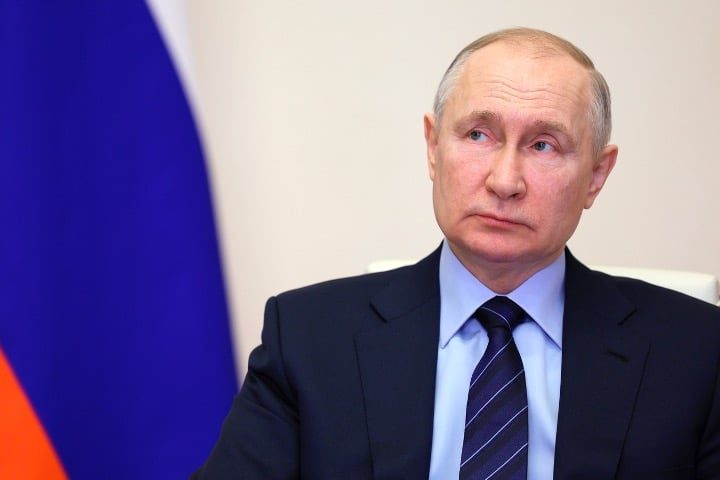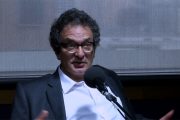
SINGAPORE — On April 18, in a rare visit, Russian President Vladimir Putin met his commanders in the Russian-occupied regions of Kherson and Luhansk in Ukraine.
Kherson, Zaporizhzhia, and Luhansk are three regions that Putin declared as annexed by Russia last September, a claim that Ukraine and its Western allies have dismissed.
According to Kremlin reports, Putin participated in a military command meeting in Ukraine’s southern Kherson Region and visited a national guard headquarters in eastern Luhansk.
Putin was briefed on the situation in the Kherson and Zaporizhzhia regions in the south by commanders of the airborne forces and the Dnieper army group, as well as other senior officers. “Vladimir Putin visited the Vostok National Guard staff in the Luhansk People’s Republic, where he received reports from Colonel General Alexander Lapin and other senior officers on the situation in that area,” the Kremlin stated.
Putin had earlier visited “the staff of the Dnieper grouping of troops in the Kherson Region, [where he] listened to reports from the commander of the Airborne Troops, Colonel General Mikhail Teplinsky, the commander of the Dnieper grouping of troops, Colonel General Oleg Makarevich and other military leadership,” according to reports from the Kremlin press service.
Putin’s visits to Kherson and Luhansk were spontaneous, and as a security precaution, neither Defense Minister Sergei Shoigu nor Chief of the General Staff Valery Gerasimov joined Putin on the trip, the Kremlin said.
This was Putin’s first visit to Luhansk People’s Republic (LPR) and Kherson Region, which joined Russia after the 2022 referendums.
The Russian president’s press service mentioned that, during his visit, Putin had wished officers a Happy Easter and given them a copy of an icon that had belonged, he posited, to “one of the most successful defense ministers of the Russian Empire.”
In March, Putin and Russian Deputy Prime Minister Marat Khusnullin made an unexpected visit to Mariupol to survey the city’s infrastructure and interact with local residents. Khusnullin reported on the progress of construction work in the city and its environs, as well as new residential micro-districts and social, educational, and health facilities.
On April 14, Defense Minister Shoigu announced an unexpected inspection of Russia’s Pacific Fleet in order to assess the Russian armed forces’ ability to “repel the aggression of a probable enemy” from the sea. On April 17, Shoigu updated Putin on the drills that had been conducted up to that point in time, saying that “more than 25,000 troops, 167 warships and logistics vessels” were involved, “including 12 submarines, as well as 89 planes and helicopters.” These had conducted “firing drills and engaged in tactical exercises involving various kinds of forces.”
Putin said that although the priorities for Russia’s armed forces were “quite clear,” primarily focusing “on the Ukrainian track and everything related to protecting people in Donbas [the primarily Russian-speaking region to the country’s east, which Russia last year annexed following a referendum] and in other new territories,” the development of the navy “including on the Pacific theater of operations remains relevant.” And Kremlin spokesman Dmitry Peskov said on Monday that the Russian naval forces’ complete combat readiness is necessary amid tumultuous times.
The Russian naval drills were concurrent with a visit to the Kremlin by Chinese Defense Minister Li Shangfu, who met with Putin and Shoigu on Orthodox Easter Sunday. It was Li’s first foreign trip as minister.
Putin told Li that while Russia and China had “maintained positive momentum” in expanding their “economic, social, cultural and educational ties,” they had also been “proactive” in their “military-to-military relations,” exemplifying the joint military exercises they had conducted in “various theaters of operation, including in the Far East, Europe, at sea, on land, as well as in the air.”
Li echoed Putin’s sentiments, saying that “as of late, military and military-technical cooperation between Russia and China is developing very well” and making a “major contribution to maintaining global and regional security.”
“We have a very strong relationship that goes beyond the Cold War-era military and political alliances,” he went on, describing their relationship as one that “hinges on the principles of non-alignment and non-confrontation with third parties,” and which had “already entered a new era.”
Under their “no limits” partnership, both Russia and China have boosted economic, military, and political ties since the onset of the Ukraine conflict in February last year. Chinese leader Xi Jinping’s visit to Moscow last month highlighted that bilateral relationship.
In response to Western critics of Russia, Russian Security Council Deputy Chairman Dmitry Medvedev said on April 18 that Western nations insist that Russia offer guarantees about nuclear weapons, but instead suggest a future nuclear conflict between Russia and NATO.
“They are endlessly hypocritical and lie to themselves and others, but they say that our country is spreading ‘false information’ about Ukraine. They demand that Russia give them some kind of guarantees about nuclear weapons, but in fact, they are hinting at a future nuclear conflict between our country and NATO,” Medvedev wrote on Telegram after a G-7 joint statement issued earlier in the day had urged Russia to return to talks with the United States to reduce nuclear risks.
In February 2023, Moscow suspended its membership in the New START, which was signed by Russia and Washington in 2010 and provided for mutual inspections of the strategic nuclear facilities of the two countries. Putin accused the U.S. of demanding that Russia unconditionally fulfill its responsibilities under the agreement, while behaving according to whim with regard to its own duties.
Later, Russian Deputy Foreign Minister Sergey Ryabkov announced the suspension of all information sharing between Russia and America under the New START. However, Moscow would continue to update Washington on ICBM and SLBM launches.
Meanwhile, on Monday, April 17, Japanese Chief Cabinet Secretary Hirokazu Matsuno complained about military drills planned by Moscow around contested islands near Japan’s northern island of Hokkaido.
The missile exercises, which Moscow notified Tokyo — a regional partner of the NATO military alliance — about in advance, are slated to take place this week. Kremlin spokesman Dmitry Peskov publicly expressed support for the drills, since these were “in strict accordance with international law.”
Japan’s territorial dispute with Moscow over the Kuril Islands dates back to the end of the Second World War, when they served as obstacles to the negotiation of a peace treaty. Following the war, the then-Soviet Union incorporated all of the islands, with Japan contesting their ownership.
In 1956, the Soviet Union and Japan ended animosities with a joint declaration, although the two countries have not signed a formal peace treaty yet.
During former Prime Minister Shinzo Abe’s tenure, Tokyo avoided using the term “illegal occupation” when referring to the islands. However, following Japan’s participation in Western sanctions on Russia, the Japanese Foreign Ministry resumed the use of the term.



